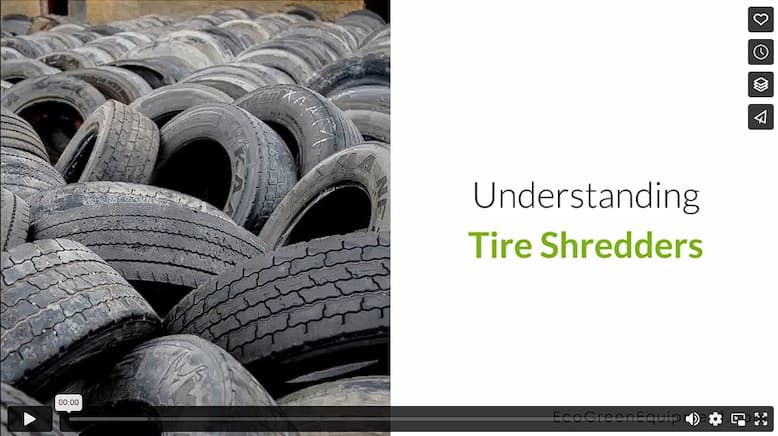When is a tire too worn to drive on safely? Tires should be changed when the tread is worn down to 2/32” and the tire no longer provides good traction while driving. At this point, the tire is no longer useful for its intended purpose. However, most of the product is still intact. Most of the rubber, metal, and nylon used to manufacture the tire are still there.
As these substances are, for the most, not biodegradable, it is a shame when they find their way into landfills. Thus, the need for tire recycling equipment. Tire shredders are capable of removing and separating out the different tire components for recycling and reuse.
Tire shredders are some of the most hard-working and robust equipment. Cutting through large truck and even mining tires, however, requires immense amounts of power and torque. The shredding process also creates a lot of wear and tear on the machine’s blades as they cut through thick rubber and metal. To make tire recycling a profitable business, recyclers must invest in high-quality machines that can be serviced quickly and easily.
Primary Shredder
The primary shredder is usually the first piece of equipment in any recycling line. This first step is where the whole tire is broken down into more manageable sizes. When recycling extremely large tires, such as those used in mining operations, you may choose to start by running the tires through a machine to remove the tire’s wire bead. This precursory step makes the rest of the shredding process easier and will help the blades last longer.
Made in both single and double shaft configurations, primary shredders make quick work of the whole tires. They can process anywhere from 10-30 tons of rubber per hour. The advantage of a single shaft shredder is that the product is usually more uniform. Single shaft shredder output can be screened. Large rubber pieces get filtered out by the screen before taking a second pass through the shredder.
Having double the shafts, however, can significantly speed up the shredding process. While double shaft shredders typically are not screened and produce shreds in the broader array of sizes, lack of uniformity may not be a problem if your primary product is crumb rubber. These machines are great at breaking down tires fast.
Grater
Also known as the secondary shredder in many lines, graters process the rough shreds produced by the primary shredder into rubber pieces one inch or smaller in size. Adding a screen to the grater is a common way to control for particle size. It is at this step in the process that the tire wire is also removed. This wire is hard on the blades of any piece of equipment and can be easily recycled with other scrap metal. Removing it at this stage makes the rest of the process down the line run more smoothly. When the rubber exits the grater, it is uniform, wire-free mulch, which is a desirable end market product for many uses in and of itself.
Granulator
Some waste rubber recycling projects require crumb rubber, which consists of rubber granules smaller than a tire grater can produce. To produce crumb rubber, recyclers feed clean rubber mulch into the granulator. Making high-quality crumb rubber may require several passes through the machine. As it is ground to particles only 3/8” in size, any remaining contaminants are also removed. A high-grade finished product should be nearly 100% free of wire, nylon, or polyester. Only clean crumb rubber will have the desired properties when mixed with asphalt or other building materials.
Cracker Mill
If rubber powder is the end product for your business, you will need a cracker mill. This piece of machinery takes an input of crumb rubber and grinds it down to a powder so fine that it is measured in millimeters. This fine-textured product is small enough to be used in manufacturing products requiring rubber-like properties, including car parts, membranes, and even new tires. The technology and applications for powder rubber continue to improve and expand.
Tire shredding equipment is a powerful lineup of machines that regularly break down some of the most rigid recycling material. With each step in the line, the tires are broken down into smaller and smaller pieces.
The rubber produced at nearly every stage by each machine is useful to someone in some application. The trick is to understand the market and your customers. Know what people are using in your area and find the machine that will make that product.
Tire shredder manufacturers continue to look for ways to improve their machinery, as well as looking for ways to expand the use of their workhorses into other recycling sectors. The health of our environment depends on this important work.
Video





